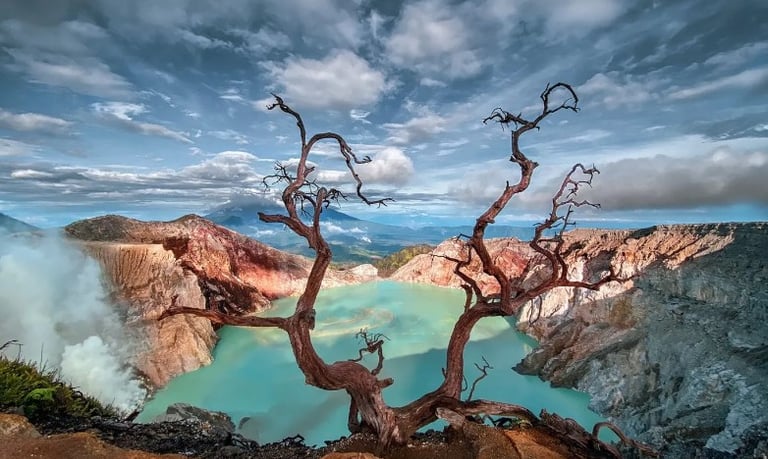Kawah Ijen, Banyuwangi: The Stunning Natural Beauty and the Enchanting Blue Flames
TRAVELING


Kawah Ijen is a tourist destination that offers breathtaking natural scenery, featuring the rare phenomenon of blue fire and stunning crater views.
Ijen Crater, located in Banyuwangi, East Java, is one of the most famous and breathtaking natural tourist destinations in Indonesia. This crater is renowned for its rare blue fire phenomenon and its stunning crater lake views. In addition to its extraordinary natural beauty, Ijen Crater also offers a range of facilities and easy access that make it increasingly convenient for tourists. This article will explore Ijen Crater in greater depth, its charm, and the facilities available for visitors.
1. The Natural Beauty of Ijen Crater
Ijen Crater is one of the active volcanoes located on the border between Banyuwangi and Bondowoso Regencies. The mountain stands at about 2,443 meters above sea level and is famous for its turquoise-colored crater lake. However, the main attraction of Ijen Crater is the blue fire phenomenon, which can only be witnessed in a few places in the world.
The blue flames are created by the combustion of sulfuric gases that emerge from the crater at extremely high temperatures, around 600 degrees Celsius, igniting a bright blue fire. This phenomenon is best seen at night, making it a stunning and unforgettable sight. It's no wonder that Ijen Crater has become a top destination for travelers, especially those who seek rare and unique natural wonders.
Aside from the blue fire, the expansive sulfuric crater lake also draws visitors. The surrounding scenery, with lush greenery and cool, fresh air, makes this area a refreshing haven for visitors seeking tranquility in nature.
2. Easy Access to Ijen Crater
One of the reasons why Ijen Crater has gained popularity is the ease of access it offers. Located about 30 kilometers from downtown Banyuwangi, Ijen Crater can be reached by private vehicles, rental cars, or public transportation. Here's how to get to Ijen Crater:
Land Transportation: From Banyuwangi city center, the journey to Ijen Crater takes about 1.5 to 2 hours. Visitors can drive or take a bus to Paltuding, the main post that serves as the starting point for the trek to the crater.
Access from Paltuding: Upon arrival at Paltuding, visitors continue the journey on foot toward the crater. The hike takes about 1.5 to 2 hours, depending on physical condition. The trail is fairly well-maintained and clearly marked, although some sections are quite steep.
Local Transportation Services: In Banyuwangi, many travel packages offer transportation to Ijen Crater, often including guided tours. These packages typically cover transport, entrance fees, and an experienced guide.
3. Facilities Available at Ijen Crater
To ensure visitor comfort and safety, Ijen Crater is equipped with various supporting facilities. Some of the main facilities include:
Paltuding Post: The starting point of the hike, Paltuding is equipped with basic amenities such as vehicle parking, food stalls, and public restrooms. It also provides information regarding the hiking trail and safety tips.
Tour Guides: Since the trek to Ijen Crater can be challenging, especially for first-time hikers, hiring a guide is highly recommended. Trained guides provide insights about the area and help ensure visitor safety.
Accommodation: Although many visitors prefer to trek to Ijen Crater at night to witness the blue fire, several accommodations are available nearby. Lodging options around Sempol Village or near Paltuding range from simple homestays to more comfortable hotels.
Food Stalls and Restaurants: Around Paltuding, there are several food vendors offering meals and drinks. Local specialties such as ruko (salted fish with chili paste) and satay can also be found.
Entrance Tickets and Cleanliness: Entrance tickets to Ijen Crater are relatively affordable and can be purchased at the Paltuding post. The area maintains its cleanliness with an adequate number of trash bins along the trail. Visitors are encouraged to keep the environment clean and avoid littering.
4. Activities at Ijen Crater
Beyond witnessing the blue fire phenomenon, there are various activities to enjoy at Ijen Crater:
Viewing the Blue Fire: The blue fire can be seen in the early hours, around 3:00 AM to 4:00 AM local time. Visitors need to start hiking at night to catch this mesmerizing natural display.
Trekking and Hiking: Hiking to the peak of Ijen Crater is a major activity. Though the trail is quite challenging, the stunning scenery along the way and the breathtaking crater lake views at the top make it a truly unforgettable experience.
Nature Photography: Ijen Crater is a paradise for photographers, both professional and amateur. Capturing the beauty of the blue fire, crater landscape, and the surrounding scenery is a must.
Observing Sulfur Miners: At Ijen Crater, visitors can observe local miners extracting sulfur by traditional methods, a practice that has been part of the local culture for generations.
5. Sustainability and Visitor Responsibility
As a natural and cultural treasure, Ijen Crater requires sustainable tourism practices. Visitors are urged to follow the rules, avoid damaging the environment, dispose of waste properly, and preserve the area. Hikers should also be cautious due to the demanding terrain and potential risks.
Conclusion
Ijen Crater is a tourist destination offering extraordinary natural beauty, rare blue fire phenomena, and a stunning crater lake. With easy access, adequate facilities, and a range of exciting activities, Ijen Crater is a must-visit for nature lovers and adventurers. Its incredible charm makes it not just a tourist destination but an unforgettable experience that leaves a lasting impression on every visitor.
